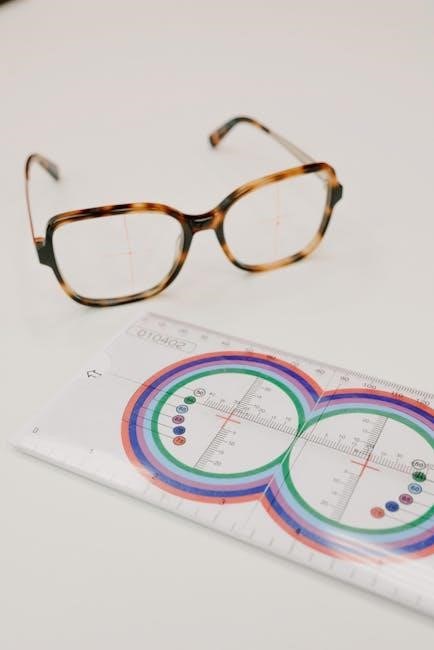The Line Bisection Test is a widely used clinical tool to assess unilateral spatial neglect, providing insights into perceptual and attentional deficits, particularly after stroke or brain injury․
Historical Background of the Line Bisection Test
The Line Bisection Test has its roots in early studies of spatial perception and cognitive neuroscience․ Initially developed in the mid-20th century, it emerged as a simple yet effective tool to assess visual-spatial biases․ The test gained prominence in clinical settings during the 1980s, particularly in the evaluation of unilateral spatial neglect (USN) following stroke or brain injury․ Researchers observed that patients with USN consistently showed deviations from the true midpoint when bisecting lines, revealing a systemic perceptual bias․ Over time, the test has been refined and standardized, becoming a cornerstone in neuropsychological assessments․ Its evolution includes adaptations for different populations and the integration of digital versions to enhance accuracy and accessibility․

What is the Line Bisection Test?
The Line Bisection Test is a neuropsychological assessment where individuals mark the midpoint of horizontal or vertical lines to evaluate spatial perception and detect unilateral spatial neglect․
Purpose of the Line Bisection Test
The primary purpose of the Line Bisection Test is to evaluate spatial perception and detect unilateral spatial neglect (USN), often resulting from stroke or brain injury․ It helps clinicians assess how individuals perceive and process visual space․ By asking patients to mark the midpoint of lines, the test identifies biases in spatial awareness, which are common in neglect syndromes․ This tool is widely used in both clinical and research settings to quantify spatial deficits and monitor recovery progress․ Its simplicity and non-invasive nature make it an essential component of neuropsychological assessments, providing valuable insights into cognitive and perceptual functioning․
Significance of the Line Bisection Test in Assessing Spatial Neglect
The Line Bisection Test holds significant importance in identifying and quantifying unilateral spatial neglect (USN), a common consequence of stroke or brain injury․ It provides a straightforward yet effective method to assess spatial perception deficits, enabling clinicians to evaluate how individuals process visual space․ By analyzing deviations from the true midpoint, the test offers insights into the severity of neglect and its impact on daily functioning․ Its simplicity and reliability make it a cornerstone in neuropsychological assessments, aiding in the diagnosis, monitoring, and rehabilitation planning for patients with spatial neglect․ This test is particularly valuable for early detection and tracking recovery progress in clinical settings․

Administration of the Line Bisection Test
The test involves marking midpoints on horizontal or vertical lines, using both hands, to assess spatial perception and detect neglect․ Standardized procedures ensure reliability․
Standard Procedure for Conducting the Test
The standard procedure involves presenting patients with horizontal or vertical lines on paper․ Patients are asked to mark the midpoint with either hand, starting with their right hand․ Measurements are taken to determine deviations from the true midpoint․ The test is typically repeated using the left hand to assess hemispheric differences․ Computerized versions may use cross-hairs for precise marking․ Instructions emphasize accuracy, and results are scored based on the distance from the midpoint․ This method ensures consistency and reliability in diagnosing spatial neglect, providing clear, quantifiable data for clinical assessment and research purposes․ The procedure is straightforward, making it accessible for widespread use in various clinical settings․
Instructions for Patients and Examiners
Patients are instructed to mark the midpoint of horizontal or vertical lines with a pen, starting with their right hand and then repeating with their left hand․ Examiners ensure the test is administered in a standardized manner, with patients sitting comfortably and looking straight ahead․ Clear instructions emphasize accuracy and the importance of marking the perceived midpoint without guessing․ Deviations from the true midpoint are measured precisely, typically to 0․5mm, to assess spatial bias․ The test is simple yet effective, requiring minimal equipment while providing valuable insights into spatial neglect․ Examiners must ensure patients understand the task and maintain focus throughout the process to ensure reliable results․ This straightforward approach makes the test accessible and efficient for clinical use․
Use of Computerized Versions of the Test
Computerized versions of the Line Bisection Test offer enhanced precision and consistency in assessing spatial neglect․ These digital tools allow patients to mark midpoints on a screen, with responses recorded electronically for accurate measurement․ Automated scoring eliminates human error, providing reliable data for clinical interpretation․ Computerized tests also enable real-time tracking of deviations from the true midpoint, facilitating detailed analysis․ Tools like Inquisit Lab and Web licenses support the administration of these tests, ensuring standardized procedures․ This digital approach streamlines the evaluation process, making it more efficient for both patients and examiners․ Additionally, computerized versions can integrate with other cognitive assessments, offering a comprehensive evaluation of spatial perception and attention․ This modern method enhances the test’s utility in clinical and research settings, ensuring precise and reproducible results․
Importance of Standardized Administration
Standardized administration of the Line Bisection Test ensures consistency and reliability in assessing spatial neglect․ By following a uniform procedure, examiners can accurately compare results across patients and over time․ This consistency minimizes variability, allowing for precise identification of neglect symptoms․ Standardization also facilitates the interpretation of deviations from the midpoint, ensuring that results are not skewed by external factors․ Clear instructions for both patients and examiners, such as demonstrating the task and using calibrated tools, are crucial․ This approach supports the test’s validity and allows for reliable clinical decision-making, making it an essential component of spatial neglect assessment in both research and clinical settings, ensuring accurate and reproducible outcomes․
Scoring and Interpretation of Results
The Line Bisection Test is scored by measuring deviations from the true midpoint, with larger deviations indicating greater neglect․ Scores are weighted and averaged to assess severity, providing a quantifiable measure of spatial bias and aiding in clinical diagnosis and monitoring of progress over time․
Scoring Methods and Metrics
The Line Bisection Test is scored by measuring the distance of the patient’s mark from the true midpoint of each line, typically recorded to 0․5mm precision․ Each line’s deviation is calculated, and the results are averaged to minimize variability․ The total score is often weighted, with higher scores indicating greater deviation from the midpoint․ For example, a maximum score of 30 may be used, with each line contributing 3 points․ The final score is divided by the number of lines to provide an average deviation per line․ This quantifiable measure allows clinicians to assess the severity of spatial neglect and track improvements over time․ Clinical cutoffs are applied to determine if the deviation exceeds normal limits, aiding in the diagnosis of unilateral spatial neglect (USN)․
Interpreting Deviations from the Midpoint
Deviations from the midpoint in the Line Bisection Test are interpreted as indicators of spatial neglect or hemispatial bias․ Patients with unilateral spatial neglect (USN) often mark the midpoint consistently to one side, typically toward the unaffected hemisphere․ The direction and magnitude of the deviation provide insights into the severity and lateralization of neglect․ Rightward deviations are commonly associated with left hemisphere damage, while leftward deviations suggest right hemisphere damage․ These deviations are not random but reflect a systematic perceptual distortion․ Clinicians interpret such errors to diagnose the presence and extent of spatial neglect, aiding in the development of targeted rehabilitation strategies․ The consistency of deviations across multiple lines strengthens the reliability of the assessment․
Clinical Cutoffs for Diagnosing Spatial Neglect
Clinical cutoffs in the Line Bisection Test help determine the presence and severity of spatial neglect․ A deviation of 10mm or more from the true midpoint is typically considered abnormal, indicating neglect․ Scores are calculated based on the distance and direction of the mark from the midpoint․ For example, a rightward deviation of 10mm or greater suggests left neglect, while a leftward deviation indicates right neglect․ These cutoffs are standardized to ensure consistency across assessments․ Clinicians use these measures to diagnose unilateral spatial neglect and monitor progress during rehabilitation․ The test’s simplicity and clear cutoffs make it a reliable tool in both clinical and research settings, aiding in early detection and intervention for patients with spatial neglect․
Advantages and Limitations
The Line Bisection Test is quick, simple, and cost-effective, making it highly accessible․ However, it may lack depth in assessing complex neglect cases and can be influenced by hemispatial bias․
Advantages of the Line Bisection Test
The Line Bisection Test offers several advantages, including its simplicity, cost-effectiveness, and non-invasive nature․ It is quick to administer, requiring minimal time and resources, making it highly accessible in clinical settings․ The test does not require specialized equipment, allowing it to be used in various healthcare environments․ Additionally, it is easy to understand for patients, reducing anxiety and ensuring reliable results․ The test’s brevity also makes it suitable for individuals with limited attention spans or cognitive impairments․ Its versatility enables its use across different patient populations, including those with stroke, brain injury, or neurological disorders․ Furthermore, it provides immediate insights into spatial neglect, aiding in early diagnosis and intervention․ These factors contribute to its widespread use in neuropsychological assessments․
Limitations and Potential Biases in the Test
The Line Bisection Test has several limitations and potential biases․ One major limitation is its reliance on motor skills, as impaired dexterity may affect accuracy․ Additionally, the test may not account for cognitive or perceptual factors beyond spatial neglect․ Age-related performance variations and cultural background can also influence results, as certain populations may interpret the task differently․ Furthermore, the test may lack sensitivity in detecting mild cases of spatial neglect, potentially leading to underdiagnosis․ Scoring interpretations can vary between examiners, introducing subjectivity․ Lastly, the test’s simplicity may limit its ability to capture the full complexity of spatial perception deficits, making it less comprehensive compared to other assessments like the Behavioural Inattention Test (BIT)․ These factors highlight the need for complementary testing to ensure accurate and reliable diagnoses․
Clinical Applications and Case Studies
The Line Bisection Test is clinically applied in diagnosing unilateral spatial neglect, especially in stroke rehabilitation․ Case studies highlight its effectiveness, such as in patients with right hemisphere damage and its use in research with elderly stroke patients and children, demonstrating its versatility in assessing spatial perception deficits across different demographics․
Use of the Test in Diagnosing Unilateral Spatial Neglect (USN)
The Line Bisection Test is a cornerstone in diagnosing Unilateral Spatial Neglect (USN), offering a straightforward yet effective method to identify perceptual biases․ Patients with USN often exhibit a consistent deviation from the true midpoint, typically towards the unaffected side․ This deviation is quantifiable, enabling clinicians to assess the severity of neglect․ The test’s simplicity and non-invasive nature make it particularly suitable for stroke rehabilitation settings․ Research has demonstrated its reliability in detecting neglect in both acute and chronic stages, with studies highlighting its effectiveness in elderly populations and its adaptability for use in children․ By providing clear, objective measures, the Line Bisection Test plays a pivotal role in tailoring rehabilitation strategies to individual patient needs, thus enhancing recovery outcomes․
Case Studies Demonstrating the Test’s Effectiveness
Case studies have consistently highlighted the Line Bisection Test’s ability to accurately diagnose and monitor spatial neglect․ For instance, a study involving 82 elderly stroke patients revealed that 40 exhibited impaired line bisection, correlating with unilateral spatial neglect․ Another case demonstrated the test’s effectiveness in identifying neglect in children, where no spatial bias was detected in those aged 3-7, underscoring its adaptability across age groups․ These real-world applications reinforce the test’s reliability in clinical settings, making it a valuable tool for rehabilitation strategies and improving patient outcomes․
Related Tests and Assessments
The Behavioural Inattention Test (BIT) and the Balloons Test are commonly used alongside the Line Bisection Test to comprehensively assess visual neglect and spatial perception deficits․
Comparison with Other Neglect Assessment Tools
The Line Bisection Test is often compared to other assessments like the Behavioural Inattention Test (BIT) and the Balloons Test, which also evaluate visual neglect․ While the BIT provides a more comprehensive evaluation of spatial neglect, the Line Bisection Test offers a quicker and more straightforward measure․ The Balloons Test, on the other hand, incorporates elements of attention and motor function, making it distinct․ The Motor-Free Visual Perception Test (MVPT-3) and the Test of Visual Perceptual Skills (TVPS-4) focus on broader visual perceptual abilities, whereas the Line Bisection Test specifically targets spatial bias․ Each tool has unique strengths, with the Line Bisection Test excelling in its simplicity and focus on unilateral spatial neglect detection․
Behavioural Inattention Test (BIT) and Its Relation to Line Bisection
The Behavioural Inattention Test (BIT) is a comprehensive assessment tool for spatial neglect, comprising conventional and behavioural subtests․ Unlike the Line Bisection Test, which focuses solely on marking midpoints, the BIT evaluates a broader range of neglect-related deficits, including visual, auditory, and tactile inattention․ While the Line Bisection Test is quicker and more specific to spatial bias, the BIT provides a more detailed profile of neglect symptoms․ Both tests are valuable but serve different clinical purposes․ The BIT offers deeper insights into functional deficits, whereas the Line Bisection Test excels in simplicity and rapid detection of unilateral spatial neglect, making them complementary tools in clinical practice․

Cultural and Demographic Considerations
Cultural factors can influence spatial perception, potentially affecting Line Bisection Test performance․ Age-related norms also exist, with variations in visual-spatial abilities across different demographic groups requiring consideration․
Cultural Factors Influencing Test Performance
Cultural background can significantly impact performance on the Line Bisection Test․ Studies suggest that visual-spatial tasks may vary across different cultures due to differing cognitive frameworks․ For instance, individuals from cultures emphasizing holistic processing may show distinct spatial biases compared to those from analytic-processing cultures․ Additionally, age-related norms play a role, as spatial perception develops early, with children as young as 3-7 showing emerging biases․ These cultural and demographic variations highlight the importance of considering individual differences when interpreting test results․ Standardized administration and normative data tailored to diverse populations are essential to ensure accurate and fair assessment of spatial neglect using the Line Bisection Test․
Age-Related Norms and Variations in Line Bisection
Research indicates that age significantly influences performance on the Line Bisection Test․ Children as young as 3-7 years old exhibit emerging spatial biases, with these tendencies becoming more pronounced with age․ Elderly individuals, particularly those with cognitive impairments, often show deviations in line bisection accuracy, which may reflect age-related declines in spatial perception․ These age-related variations highlight the importance of establishing normative data across different age groups to ensure accurate test interpretation․ Understanding these developmental changes is crucial for diagnosing and managing spatial neglect effectively in diverse populations․

Future Directions and Research
Advancements in technology are enhancing the accessibility and accuracy of the Line Bisection Test, while ongoing research explores its integration with other cognitive assessments for comprehensive patient evaluation․
Technological Advancements in Line Bisection Testing
Technological advancements have significantly enhanced the administration and interpretation of the Line Bisection Test․ Computerized versions of the test now allow for precise measurement of deviations from the midpoint, reducing human error․ Digital platforms enable real-time data collection, facilitating quicker analysis and reporting․ Additionally, touchscreen devices and eye-tracking technology are being integrated to improve accuracy and accessibility․ These innovations also support remote testing, making the assessment more convenient for patients with mobility limitations․ Furthermore, AI-driven algorithms can analyze test results to detect subtle patterns, aiding in early detection of spatial neglect․ Such advancements not only streamline the process but also contribute to more reliable and consistent outcomes in clinical and research settings․
Integration with Other Cognitive and Motor Assessments
The Line Bisection Test is often integrated with other cognitive and motor assessments to provide a comprehensive evaluation of a patient’s spatial perception and neglect symptoms․ Combining it with tests like the Behavioural Inattention Test (BIT) or the Trail Making Test (TMT) offers a more holistic understanding of cognitive deficits․ Additionally, motor assessments, such as the Motor-Free Visual Perception Test (MVPT-3), can be used alongside the Line Bisection Test to evaluate how spatial neglect impacts motor functions․ This integrated approach helps clinicians identify the extent of cognitive and motor impairments, enabling more accurate diagnoses and tailored rehabilitation plans․ Such combinations also facilitate long-term monitoring of recovery and adaptation strategies in patients with spatial neglect;
The Line Bisection Test remains a cornerstone in assessing unilateral spatial neglect, offering a quick and straightforward method to detect perceptual biases․ Its simplicity and effectiveness make it invaluable in clinical settings for diagnosing and monitoring recovery in patients with spatial neglect․ By integrating it with other cognitive and motor assessments, clinicians gain a more comprehensive understanding of a patient’s deficits․ Technological advancements have further enhanced its accessibility and precision, ensuring its continued relevance in neuropsychological evaluations․ As research evolves, the Line Bisection Test will remain a critical tool in understanding and addressing spatial perception impairments, aiding in the development of targeted rehabilitation strategies․
